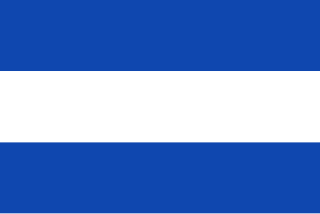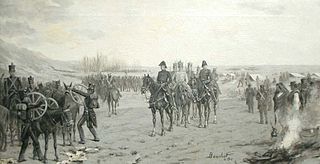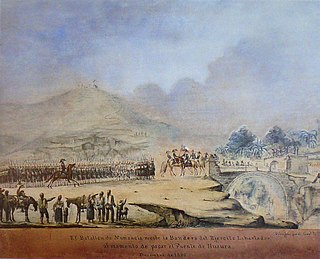Related Research Articles

Mendoza, officially Province of Mendoza, is a province of Argentina, in the western central part of the country in the Cuyo region. It borders San Juan to the north, La Pampa and Neuquén to the south, San Luis to the east, and the republic of Chile to the west; the international limit is marked by the Andes mountain range. Its capital city is the homonymous city of Mendoza.

The Viceroyalty of Peru was a Spanish imperial provincial administrative district, created in 1542, that originally contained modern-day Peru and most of the Spanish Empire in South America, governed from the capital of Lima. The Viceroyalty of Peru was officially called the Kingdom of Peru. Peru was one of the two Spanish Viceroyalties in the Americas from the sixteenth to the eighteenth centuries.

José Francisco de San Martín y Matorras, known simply as José de San Martín or the Liberator of Argentina, Chile and Peru, was an Argentine general and the primary leader of the southern and central parts of South America's successful struggle for independence from the Spanish Empire who served as the Protector of Peru. Born in Yapeyú, Corrientes, in modern-day Argentina, he left the Viceroyalty of the Río de la Plata at the early age of seven to study in Málaga, Spain.

San Juan Province is a province of Argentina, located in the western part of the country. Neighbouring provinces are, moving clockwise from the north, La Rioja, San Luis and Mendoza. It borders with Chile to the west.

Mendoza, officially the City of Mendoza is the capital of the province of Mendoza in Argentina. It is located in the northern-central part of the province, in a region of foothills and high plains, on the eastern side of the Andes. As of the 2010 census [INDEC], Mendoza had a population of 115,041 with a metropolitan population of 1,055,679, making Greater Mendoza the fourth largest census metropolitan area in the country.

The Argentine War of Independence was a secessionist civil war fought from 1810 to 1818 by Argentine patriotic forces under Manuel Belgrano, Juan José Castelli and José de San Martín against royalist forces loyal to the Spanish crown. On July 9, 1816, an assembly met in San Miguel de Tucumán, declaring independence with provisions for a national constitution.

The Viceroyalty of the Río de la Plata meaning "River of the Silver", also called "Viceroyalty of the River Plate" in some scholarly writings, in southern South America, was the last to be organized and also the shortest-lived of the Viceroyalties of the Spanish Empire in the Americas. The name "Provincias del Río de la Plata" was formally adopted in 1810 during the Cortes of Cádiz to designate the Viceroyalty of the Río de la Plata
The military history of Argentina spans a period of over two centuries. During the course of those years, it broke colonial ties with Spain, waged a civil war to define its organization and wars with Brazil, Paraguay, Britain and France. The military also played a role in the institutional life of the country, during a series of coups d'état that took place in the 20th century.

Cuyo is the wine-producing, mountainous region of central-west Argentina. Historically it comprised the provinces of San Juan, San Luis and Mendoza. The modern New Cuyo includes both Cuyo proper and the province of La Rioja. New Cuyo is a political and economic macroregion, but culturally La Rioja is part of the North-West rather than of Cuyo.

The Captaincy General of Chile or Governorate of Chile, was a territory of the Spanish Empire, from 1541 to 1818. It comprised most of modern-day Chile and southern parts of Argentina. Its capital was Santiago de Chile. In 1818 it declared itself independent, becoming the Republic of Chile. It had a number of Spanish governors over its long history and several kings.

The United Provinces of the Río de la Plata, earlier known as the United Provinces of South America, was a name adopted in 1816 by the Congress of Tucumán for the region of South America that declared independence in 1816, with the Sovereign Congress taking place in 1813, during the Argentine War of Independence (1810–1818) that began with the May Revolution in 1810. It originally comprised rebellious territories of the former Spanish Viceroyalty of the Río de la Plata dependencies and had Buenos Aires as its capital.

The Crossing of the Andes was one of the most important feats in the Argentine and Chilean wars of independence, in which a combined army of Argentine soldiers and Chilean exiles invaded Chile crossing the Andes range separating Argentina from Chile, leading to Chile's liberation from Spanish rule.

The Army of the Andes was a military force created by the United Provinces of the Río de la Plata (Argentina) and mustered by general José de San Martín in his campaign to free Chile from the Spanish Empire. In 1817, it crossed the Andes Mountains from the Argentine province of Cuyo, and succeeded in its objective by dislodging the Spanish from the country.

Grand Marshal Juan Gregorio de las Heras was an Argentine soldier who took part in the Spanish American wars of independence and was also a governor of the province of Buenos Aires.

The Liberating Expedition of Peru was a naval and land military force created in 1820 by the government of Chile in continuation of the plan of the Argentine General José de San Martín to achieve the independence of Peru, and thus consolidate the independence of all former Spanish-American colonies. It was vital to defeat the Viceroyalty of Peru—the center of royalist power in South America—from where royalist expeditions were sent to reconquer the territories lost to the independence fighters.

The Governorate of New Andalusia was a Spanish Governorate of the Crown of Castile in South America which existed between 1534–1617.

The Huarpes or Warpes are an indigenous people of Argentina, living in the Cuyo region. Some scholars assume that in the Huarpe language, this word means "sandy ground," but according to Arte y Vocabulario de la lengua general del Reino de Chile, written by Andrés Febrés in Lima in 1765, the word Cuyo comes from Araucanian cuyum puulli, meaning "sandy land" or "desert country".

Chile–Spain relations refers to the current and historical relations between Chile and Spain. Both nations are members of the Association of Spanish Language Academies, Organization of Ibero-American States, Organisation for Economic Co-operation and Development and the United Nations.
Captaincies were military and administrative divisions in colonial Spanish America and the Spanish Philippines, established in areas under risk of foreign invasion or Indian attack. They could consist of just one province, or group several together. These captaincies general should be distinguished from the ones given to almost all of the conquistadores, which was based on an older tradition. During the Reconquista, the term "captain general" and similar ones had been used for the official in charge of all the troops in a given district. This office was transferred to America during the conquest and was usually granted along with the hereditary governorship to the adelantado in the patent issued by the Crown. This established a precedent that was recognized by the New Laws of 1542, but ultimately the crown eliminated all hereditary governorships in its overseas possessions.

Chilean expansionism refers to the foreign policy of Chile to expand its territorial control over key strategic locations and economic resources as a means to ensure its national security and assert its power in South America. Chile's significant territorial acquisitions, which occurred mostly throughout the 19th century, paved the way for its emergence as a thalassocracy and one of the three most powerful and wealthiest states in South America during the 20th century. It also formed Chile's geopolitical and national identity as a tricontinental state and one of the countries with the longest coastlines in the world.
References
- ↑ Dawson, Thomas Cleland (1903). The South American Republics: Argentina, Paraguay, Uruguay, Brazil. G.P. Putnam's Sons. p. 123.